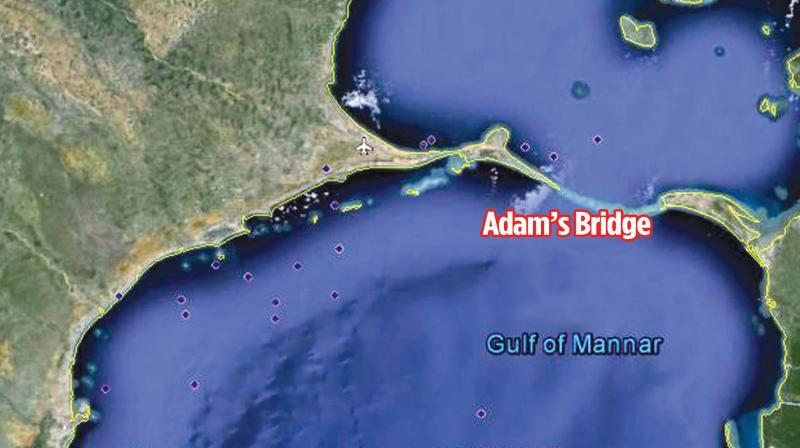Ram Setu 18,400 years old: Study
Adam's Bridge is a 35 km long stretch of shoal and sandbank under the sea between Pamban Island of Tamil Nadu and Mannar Island of Sri Lanka.

Chennai: The Adam’s Bridge, aka Rama Setu, was formed about 18,400 years ago, according to researchers from the Anna University and the Madras University, who said their study was the first of its kind done on samples taken from the drilled core surface in the depths of Gulf of Mannar off Rameswaram.
Adam’s Bridge is a 35 km long stretch of shoal and sandbank under the sea between Pamban Island of Tamil Nadu and Mannar Island of Sri Lanka. The bridge which is submerged in the water is roughly 100 meters wide and up to 10 metres in depth.
The research funded by University Grants Commission (UGC) and the Indian National Centre for Ocean Information Service (INCOIS) was carried out to know the past of the Gulf of Mannar region, which did not get affected by disasters such as 2004 tsunami. Scientists have found marine terraces which had a steeper descending slope on the seaward side near the Rameswaram islands.
Suspecting tectonic activity which could have caused the submarine landslide and vertical slopes in the region, they took samples at three places including one sample on the slope of the bridge. The water depth at the slope was 260 metres and the core sample was taken for 1.3 metres on December 12, 2015.
They looked for the microfossil called Cibicides margaritiferus to know more about the region’s past and also about the formation of the structure in the marine sediment of Adam’s Bridge.
“The microfossil Cibicides margaritiferus was almost nil up to 75 cm depth and after that, we found the fossil in good numbers. The sediments taken at the depth of 130 cm in the seabed, had microfossil around 300-350 per 10 gram”, said Professor Srinivasalu from Institute of Ocean Management, Anna University and the Principal Investigator of the project.
Since the shell-shaped fossils are rare to find on the east coast of India, scientists wanted to find out the time period of the fossils. “We knew something major had happened in that period. These fossils are also very sensitive to the climate and environmental changes and major incidents like tsunami or earthquake can wipe out its population. So, the samples were sent to US-based Beta Analytics, one of the top radiocarbon dating labs to determine the exact time period”, he told Deccan Chronicle.
The lab has determined the age of fossil using Carbon-14 dating method. The method uses organic remains of the fossil to find out the time period of its death.
The results showed that the fossils found between 94 cm and 132 cm were at least 18,400 years old. The fossils in the marine sediment between 35 cm and 94 cm were 700-780 years old.
“It’s a major finding as we are one of the first groups to have scientifically got the samples from Adams Bridge. Now, it has been confirmed that the structure was formed at least 18,400 years ago,” Professor Srinivasalu said. The results also revealed that the region had a major undersea earthquake around 700 years ago.
“There were research publications indicating Indonesia and Thailand, Sri Lanka, Andaman had records of a major Tsunami and earthquake around the same time. But, there is no study that showed any quake affecting the east coast of India. This is the first study to find the evidence for an earthquake in the Bay of Bengal,” he added.
Scientists are surprised to find out the earthquake in the seismically passive Gulf of Mannar. “It was a major earthquake and tsunami happened 700 years ago and affected several countries like in 2004. It may again hit in future and we need to be prepared,” scientists said. G.Kalpana, a researcher from Anna University and Professors N.Rajeswara Rao and M.Jayaprakash from the Department of Applied Geology at Madras University also contributed to this study.

